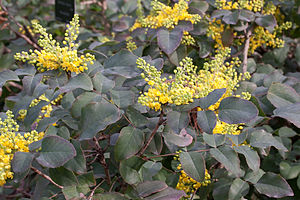- Mahonia repens
-
Mahonia repens
Creeping Mahonia
Scientific classification Kingdom: Plantae Division: Magnoliophyta Class: Magnoliopsida Order: Ranunculales Family: Berberidaceae Genus: Mahonia Species: M. repens Binomial name Mahonia repens
(Lindl.) G. DonSynonyms Berberis aquifolium var. repens
(Lindl.) Scoggan (2011)Mahonia Repens or Berberis aquifolium var. repens, with the common names Creeping Mahonia, Creeping Oregon-grape, Creeping barberry, Prostrate barberry, is the species of Mahonia native to the Rocky Mountains and westward areas of North America, from British Columbia and Alberta in the north through Arizona and New Mexico into northwest Mexico in the south.[1] It is also found in many areas of California [2] and the Great Basin region in Nevada.[1]
Some authors place the genus mahonia in the barberry genus berberis, as Berberis aquifolium var. repens or Berberis repens [3]
Contents
Description
Mahonia Repens, Creeping mahonia, is a typical mahonia with conspicuous matt blue berries and shiny leaves.[2] It grows as a subshrub.[1] The yellow flowers appear in the middle of spring, and the blue berries in early summer. Although it is evergreen, in fall the leaves turn an attracting bronze. It slowly spreads. The plant is found at elevations from 300 metres (980 ft) to 2,200 metres (7,200 ft).[2]
Uses
Medicinal
The Tolowa and Karok Indians of Northwest California used the roots for a blood and cough tonic. The Hopi, Paiute, Navajo, Shoshoni, Blackfoot, Cheyenne, Mendocino, and other tribes also used the plant for medicinal, food, and ceremonial needs. [4]
Cultivation
Creeping Mahonia is cultivated as an ornamental plant for use in natural landscaping; and in water conserving - drought tolerant, traditional residential, native plant habitat and wildlife gardens.[5] It is a low-water needing ground cover for shade and brighter habitats—locations, and in gardens under oaks to reduce or eliminate irrigation that can threaten mature Quercus trees. Berries and foliage are resistant to browsing by deer.
It is a 'year-round attractive' hardy plant, tolerant of drought, frost and heat, so it is popular with landscape designers and gardeners. It can provide good ground cover in a cold situation. In garden conditions, and where their ranges overlap in nature, this species hybridises readily with Oregon-grape (Mahonia aquifolium), and the hybrids are less prostrate in their habit than the pure stock.
References
- ^ a b c USDA - M. repans . accessed 8.30.2011
- ^ a b c Jepson treatment - B. aquifolium var. repans . accessed 8.30.2011
- ^ Jepson lede . accessed 8.30.2011
- ^ Univ. of Michigan-Dearborn: Native American Ethnobotany for M. repans . accessed 8.30.2011
- ^ Missouri Bot. Garden-Kemper Center for Home Gardening . accessed 8.30.2011
External links
- USDA PLANTS database: Entry for Mahonia repens
- UC Jepson treatment of Berberis aquifolium var. repens
- Mahonia repens - UC/CalPhotos Gallery
Categories:- Mahonia
- Berberis
- Flora of the Western United States
- Flora of Western Canada
- Flora of the North-Central United States
- Flora of the Northwestern United States
- Flora of California
- Flora of Northwestern Mexico
- Flora of the Rocky Mountains
- Flora of the Sierra Nevada region (U.S.)
- Flora of the Great Basin desert region
- Garden plants of North America
- Drought-tolerant plants
- Groundcovers
- Bird food plants
Wikimedia Foundation. 2010.

